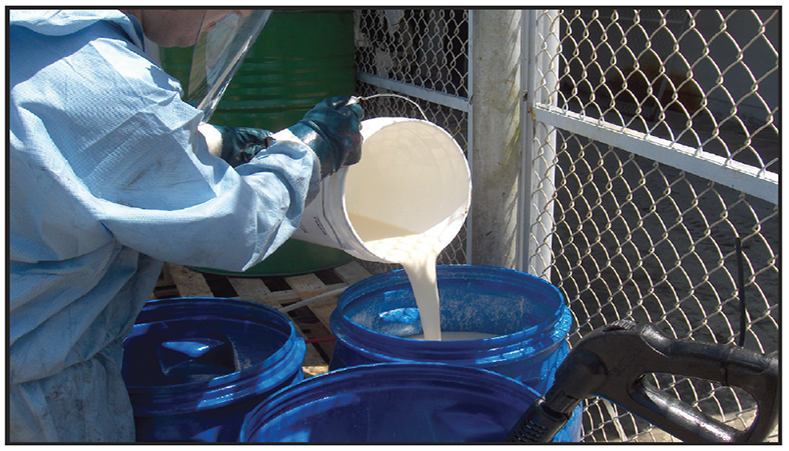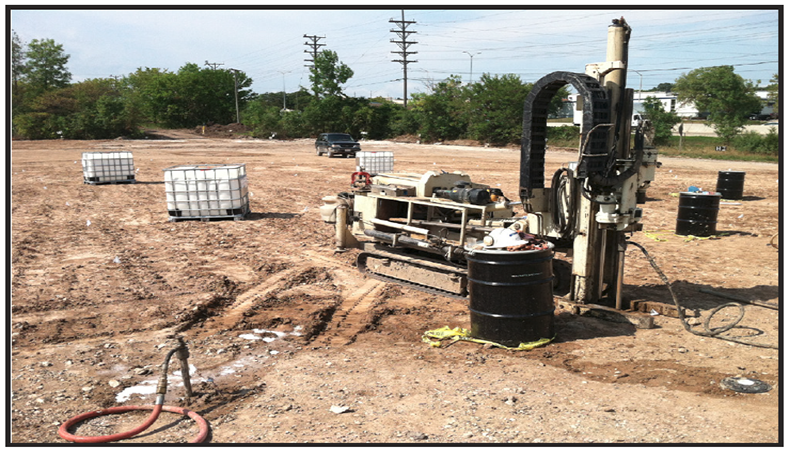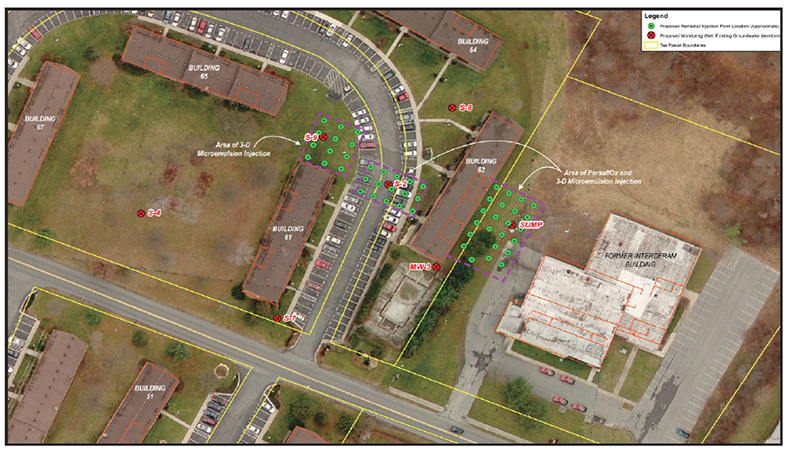Combined Remedies Treat Chlorinated Solvents at Gulf Coast Superfund Site
Former Industrial Facility and Landfill Pilot Test Shows Rapid Reduction in PCE, TCE and 1,2 DCE
Project Highlights
- Superfund Site once housed an industrial facility and landfill.
- Rapid reduction needed to avoid off-site migration of daughter products.
- Simultaneous application of Enhanced Aerobic Biodegradation, Bioaugmentation and In Situ Chemical Reduction (ISCR).
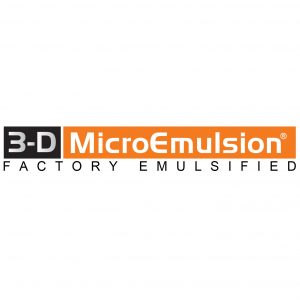
Project Summary
This former industrial property had a landfill that was used in the mid-1900s for disposal of magnesium dross and refractory brick as well as breakout material from electrolytic chlorine cells. As much as 254,000 cubic feet of material were removed from the landfill although a large chlorinated solvent plume remains both from landfill waste below the water table and from industrial operations on-site. A feasibility study for the site was approved in 2012 which evaluated the use of enhanced reductive dechlorination to treat dissolved chlorinated solvents at the site and to prevent off-site migration past the property boundary and beneath a highway. A pilot test to evaluate at least two different biological amendments was conducted and Regenesis supplied 3D Microemulsion, BDI, and CRS for the evaluation. Three aquifers exist at the site, but the pilot test was performed in the first groundwater bearing unit only.
Remediation Approach
After a review of sulfate concentrations, other natural attenuation data, and cVOC concentrations it was determined that the optimal treatment choice would be to test a combination of an electron donor in the form of 3-D Mircoemulsion®, a bioaugmentation culture called Bio-Dechlor INOCULUM® Plus, and the use of Chemical Reducing Solution® (CRS) to prevent any hydrogen sulfide toxicity and to promote a level of beneficial in situ chemical reduction (ISCR). For the pilot test 10 injections points were used to place 800 pounds of 3-D Microemulsion, 18 liters of BDI Plus and 400 pounds of CRS. The product was injected over a 10-foot interval.
The goal for this project was to attain as rapid reduction as possible for the site specifically to avoid off-site migration of daughter products such as vinyl chloride. Therefore, it was deemed beneficial to inject all three proposed products at once. The product was injected in March 2014 and results at roughly 1 month post injection are extremely promising. PCE has been reduced from 134 ppb to 1.57 ppb, TCE from 271 ppb to 1.77 ppb, and cic-1,2-DCE from 235 ppb to 4.25 ppb. Vinyl Chloride has shown some increase from non-detect to 13 ppb.
However, Dehalococcoides has increased from non-detect to 7 x 10×5 cells/bead and vinyl chloride reduced from non-detect to 9 x 10×4 cells per bead which strongly correlates to the rapid enhanced reductive dechlorination.
Technology Description
3-D Microemulsion is an engineered electron donor material that offers a novel 3-stage electron donor release profile, pH neutral chemistry and is delivered on-site as a factory emulsified product.
BDI Plus is an enriched natural microbial consortium containing species of Dehalococcoides sp. (DHC). This microbial consortium has since been enriched to increase its ability to rapidly dechlorinate contaminants during in situ bioremediation processes.
CRS (Chemical Reducing Solution) is an iron-based amendment for in situ chemical reduction (ISCR) of halogenated hydrocarbon contaminants such as chlorinated ethenes and ethanes.
Chlorinated Solvent Concentrations Reduced >100x within Six Months
Enhanced Reductive Dechlorination Used to Treat Former Dry Cleaner in South Carolina Coastal Plain
Project Highlights
- Small groundwater recovery system in place to provide hydraulic control.
- Enhanced Reductive Dechlorination (ERD) treatment selected to achieve site closure more quickly.
- High PCE concentrations reduced by more than 100x within 6 months and remain
- Follow-up treatments enhanced initial injection and contributed to continued dechlorination.
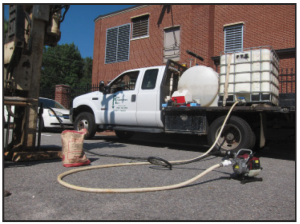
Project Summary
The site, located in the Coastal Plain of South Carolina, was impacted from former dry cleaning operations. A small groundwater recovery system had historically been used to provide hydraulic control, but the site owner wanted to move the site toward closure more quickly. Enhanced Reductive Dechlorination (ERD) with 3-D Microemulsion® was selected based on cost, ease-of-use and expected remediation performance. After the initial injection, PCE concentrations decreased by more than 100x within 6 months of application and remain below 5 ug/L two years after the initial injection.
Remediation Approach
The core of the plume was characterized by concentrations of 14-18 mg/L PCE at baseline plus the full suite of chlorinated ethene daughter products. An initial application of 3-D Microemulsion occurred in June 2011 over a 7,750-square-foot area in the surficial aquifer from 3-25 feet below ground surface. The injections were completed using direct-push equipment into temporary borings on 13-20 foot centers. Based on the success of the initial injection, a follow-up injection was completed in September 2013 over a much smaller footprint (2,200 square feet) to fill in treatment gaps near the upgradient edge of the initial treatment area and to supplement the 3-D Microemulsion in the core of the plume. The follow-up treatment has built on the initial treatment and is contributing to continued depletion of the chlorinated solvents.
Technology Description
3-D Microemulsion is an engineered electron donor material that offers a novel 3-stage electron donor release profile, pH neutral chemistry and is delivered on-site as a factory-emulsified product.
Chlorinated Solvents in Soil, Gas, and Groundwater Remediated at Former Manufacturing Facility
No Further Action” Status Achieved at Ohio Brownfields Site
Project Highlights
- Integrated Site Remediation coupling enhanced reductive dechlorination (ERD) and vapor mitigation was implemented to address the immediate risk of vapor intrusion and the long-term risk of identified CVOCs in groundwater.
- Combined remedy approach allowed site to be redeveloped as an apartment complex roughly 6 months following the groundwater treatment.
- “No Further Action” status and covenant not to sue letter was granted in 2013.
- Cost for groundwater water treatment was approximately $10 per cubic yard (product and application) and vapor intrusion mitigation was $3.34 per square foot with no long term O&M required.
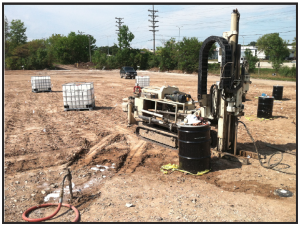
Project Summary
The site, a former industrial magnet manufacturing facility in Ohio, received a $2.34 million Clean Ohio Revitalization Fund grant through the Ohio Department of Development in 2011. Site investigation activities identified chlorinated VOCs in groundwater and vapors above the state regulatory limits. Using a combined approach of ERD with vapor mitigation addressed the immediate risk of vapor intrusion and the long-term risk of groundwater impacts. By implementing this strategy, the site was allowed to be redeveloped as an apartment complex roughly 6 months following the groundwater treatment. “No Further Action” status and covenant not to sue letter was granted in 2013. The site currently operates as a residential apartment complex.
Remediation Approach
In the Spring of 2012, ERD using 3-D Microemulsion® and Bio-Dechlor INOCULUM® Plus was implemented within the defined 24,000-square-foot treatment area via direct-push injection. In Fall 2012, the Geo-Seal™ vapor barrier system was installed below a 15,522-square-foot apartment complex raised at the site. The cost for groundwater treatment was approximately $10/cy (product and application) and Geo-Seal was $3.34/sf (product and installation).
Technology Description
3-D Microemulsion is an engineered electron donor material that offers a novel 3-stage electron donor release profile, pH neutral chemistry and is delivered on-site as a factory emulsified product.
Bio-Dechlor INOCULUM Plus is an enriched natural microbial consortium containing species of Dehalococcoides sp. (DHC). This microbial consortium has since been enriched to increase its ability to rapidly dechlorinate contaminants during in situ bioremediation processes.
Geo-Seal is a composite system that creates the ideal blend between constructability and chemical resistance by using both high density polyethylene (HDPE) and spray applied asphalt latex.
Active Manufacturing Facility Remediated to Compliance Levels
Extensive Chlorinated Solvents Contamination Treated with Combined Remedies
Project Highlights
- Active manufacturing and low permeability soil caused application limitations.
- Combined use of 3-D Microemulsion®, Hydrogen Release Compound® (HRC) and Chemical Reducing Solution® (CRS) were used for the remediation approach.
- Significant reductions were observed in TCE, DCE and VC post-application.
- Site closure is pending regulatory approval.
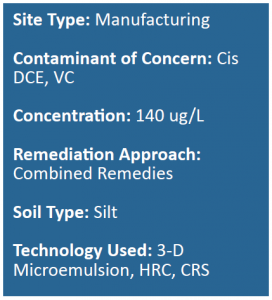
Project Summary
The site, located in Southern New Hampshire, was contaminated with chlorinated solvents in soils, groundwater and surface water beneath and adjacent to a former industrial facility. After investigations to characterize the extent of contamination beneath and adjacent to the industrial facility caused by spills and aggravated by leaks in a storm drain underlying the building, a remedial action was designed and implemented. HRC applications were completed February 2008 and March 2011 to reduce cVOC levels in groundwater. The site had limitations that included reduced access because of active manufacturing inside the building and soil had reduced permeability. Significant reductions were observed in TCE, DCE and VC after the application. However, two wells remained above standards for DCE and VC with the assumption that HRC was not adequately distributed in that area. An application of 3-D Microemulsion® and CRS® was completed in May 2013. Significant reductions of DCE and VC were observed and levels were rapidly brought into compliance.
Remediation Approach
HRC was applied to stimulate the biodegradation of chlorinated solvents. Permanent re-injection points were installed in a grid layout so as to make it easy for re-application without additional construction or drilling activities. Surface water contamination was caused by contaminated groundwater leaking into the storm drain with discharge to the headwaters of a small stream downgradient of the facility. The contamination was addressed by air sparging within the drain pipe near the discharge point but before water discharged to the stream. The discovery of soil contamination causing low level groundwater contamination was addressed by excavating the soil source and disposing the soil off-site.
In the first three years after HRC injection, ¾ of the site was remediated at three source locations. One source area beneath the building exhibited persistent groundwater contamination. The remaining contamination appears to have been caused by poor HRC distribution resulting from underground cement blocks and low permeability soils. 3-D Microemulsion and CRS were injected at two locations surrounding where hot spots of 1,2-DCE and VC persisted at high levels. Recent measurements show significant reductions in the groundwater contamination indicating successful bio-stimulation of chlorinated solvent degraders in the hot spot areas.
Currently the site is under a Groundwater Management Permit which establishes a Groundwater Management Zone with eleven monitoring wells and one surface water monitoring point. Recent monitoring results show dramatic decreases in groundwater concentrations at the location of contamination persistence, and site closure is now projected to occur in the near future.
Technology Description
3-D Microemulsion factory emulsified is an engineered electron donor material that offers a novel 3-stage electron donor release profile, pH neutral chemistry and is delivered on-site as a factory–emulsified product.
HRC is a controlled release, electron donor material, that when hydrated is specifically designed to produce a controlled release of lactic acid. The newly available lactic acid is critical for the production of hydrogen to fuel anaerobic biodegradation processes in soil and groundwater.
CRS (Chemical Reducing Solution) is an iron-based amendment for in situ chemical reduction (ISCR) of halogenated hydrocarbon contaminants such as chlorinated ethenes and ethanes.
PCE Treated at Active Dry Cleaner in Less Than 200 Days
Project Receives “No Further Action” Letter Following Combined Application of 3-D Microemulsion® and BDI® Plus
Project Highlights
- Enhanced reductive dechlorination used to treat PCE contamination under an active dry cleaning facility
- Total cVOC concentrations reduced by three orders of magnitude in less than 200 days
- Total cVOC concentrations were below remediation goal

Project Summary
Groundwater below a Missouri dry cleaning facility was contaminated from a cleaning solvent spill, resulting in PCE concentrations >4,000 μg/L. An enhanced reductive dechlorination approach was developed that integrated biodegradation and bioaugmentation via application of a controlled-release electron donor and a microbial consortium of dechlorinating bacteria.
REGENESIS® Remediation Services (RRS) was contracted to co-apply 3-D Microemulsion® and Bio-Dechlor Inoculum® Plus to the affected groundwater. The products were applied to the affected groundwater underneath the building via direct-push injections.
Technology Description
3-D Microemulsion factory emulsified is an engineered electron donor material that offers a novel 3-stage electron donor release profile, pH neutral chemistry and is delivered on-site as a factory-emulsified product.
Bio-Dechlor INOCULUM Plus is an enriched natural microbial consortium containing species of Dehalococcoides sp. (DHC). This microbial consortium has since been enriched to increase its ability to rapidly dechlorinate contaminants during in situ bioremediation processes.
Results
Following treatment, total cVOC were reduced by 99.9%. Concentrations were reduced by three orders of magnitude from a baseline concentration of >4,000 μg/L to <10 μg/L in less than 200 days.
Furthermore, monitoring data indicated complete dechlorination with no remaining daughter products above the remediation goals. As a result of the rapid and complete reduction of chlorinated solvents, the project received a “No Further Action” letter (NFA) through the Missouri Department of Natural Resources.
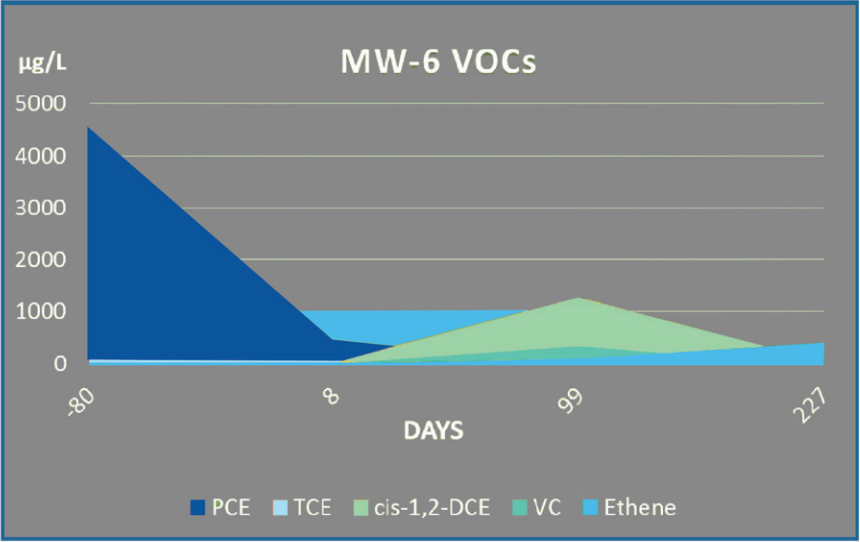
| Download the PDF |
Project Receives “No Further Action” Letter Following Combined Application of 3-D Microemulsion® and BDI® Plus
Project Highlights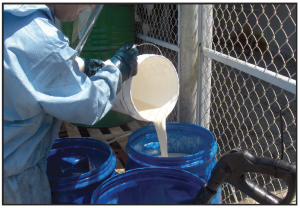
- Enhanced reductive dechlorination used to treat PCE contamination under an active dry cleaning facility
- Total cVOC concentrations reduced by three orders of magnitude in less than 200 days
- Total cVOC concentrations were below remediation goals
Project Summary
Groundwater below a Missouri dry cleaning facility was contaminated from a cleaning solvent spill, resulting in PCE concentrations >4,000 μg/L. An enhanced reductive dechlorination approach was developed that integrated biodegradation and bioaugmentation via application of a controlled-release electron donor and a microbial consortium of dechlorinating bacteria.
REGENESIS® Remediation Services (RRS) was contracted to co-apply 3-D Microemulsion® and Bio-Dechlor Inoculum® Plus to the affected groundwater. The products were applied to the affected groundwater underneath the building via direct-push injections.
Technology Description
3-D Microemulsion factory emulsified is an engineered electron donor material that offers a novel 3-stage electron donor release profile, pH neutral chemistry and is delivered on-site as a factory-emulsified product.
Bio-Dechlor INOCULUM Plus is an enriched natural microbial consortium containing species of Dehalococcoides sp. (DHC). This microbial consortium has since been enriched to increase its ability to rapidly dechlorinate contaminants during in situ bioremediation processes.
Results

Following treatment, total cVOC were reduced by 99.9%. Concentrations were reduced by three orders of magnitude from a baseline concentration of >4,000 μg/L to <10 μg/L in less than 200 days.
Furthermore, monitoring data indicated complete dechlorination with no remaining daughter products above the remediation goals. As a result of the rapid and complete reduction of chlorinated solvents, the project received a “No Further Action” letter (NFA) through the Missouri Department of Natural Resources.
Combined Remedies Used at Former Chemical Company in Illinois, USA
cVOCs in Bedrock Treated at Active Manufacturing Facility
Project Highlights
- Regenesis Remediation Services (RRS) used combined technologies to work toward the shutdown of a pump and treat (P&T) system.
- Previous Enhanced Reductive Dechlorination (ERD) technology applications did not achieve COC reductions.
- Advanced ERD, Bioaugmentation and ISCR remedies were combined and applied into weathered bedrock.
- The project required RRS to be PICS certified. PICS is a contractor prequalification services used many large E&C and fortune 500 companies.
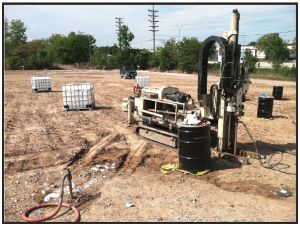
Project Summary
The site is home to an active chemical manufacturing facility with historic spills of cVOCs. Within the contamination impact zones, a groundwater P&T system is being used to mitigate off-site migration of cVOCs in the groundwater. The consultant was seeking ways to turn off the P&T system by treating the plume in-situ. They had previously used an ERD technology without fully achieving primary COC reductions. RRS designed and implemented a pilot study for the site.
Remediation Approach
The pilot study was designed to test Regenesis’ combined remedy approach which incorporated ERD using 3-D Microemulsion, Bioaugmentation with BDI Plus and ISCR with CRS. RRS applied the integrated technologies through direct-push borings. The 2,500-square-foot treatment zone included 10-foot vertical injections into silty sand and clay over weathered dolomite bedrock.
Technology Description
- 3-D Microemulsion is an engineered electron donor material that offers a novel 3-stage electron donor release profile, pH neutral chemistry and is delivered on-site as a factory–emulsified product.
- HRC Primer is a less viscous version of the standard Hydrogen Release Compound (HRC) product. It is a thinner, water-like compound that is typically injected into an aquifer where it releases lactic acid at a rate faster than standard HRC (several weeks), but at a slower, more controlled rate than dispersing aqueous simple sugar solutions or straight lactic acid (several days).
- Bio-Dechlor INOCULUM Plus is an enriched natural microbial consortium containing species of Dehalococcoides sp. (DHC). This microbial consortium has since been enriched to increase its ability to rapidly dechlorinate contaminants during in situ bioremediation processes.
- CRS® (Chemical Reducing Solution) is an iron-based amendment for in situ chemical reduction (ISCR) of halogenated hydrocarbon contaminants such as chlorinated ethenes and ethanes.
Combined Remedies Used at Historic Illinois Chemical Company
cVOCs in Bedrock Treated at Active Manufacturing Facility
Project Highlights
- Regenesis Remediation Services (RRS) used combined technologies to work toward the shutdown of a pump and treat (P&T) system.
- Previous Enhanced Reductive Dechlorination (ERD) technology applications did not achieve COC reductions.
- Advanced ERD, Bioaugmentation and ISCR remedies were combined and applied into weathered bedrock.
- The project required RRS to be PICS certified. PICS is a contractor prequalification services used many large E&C and fortune 500 companies.
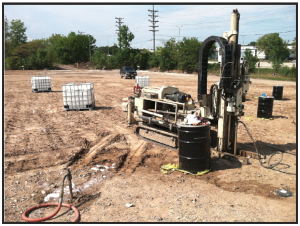
Project Summary
The site is home to an active chemical manufacturing facility with historic spills of cVOCs. Within the contamination impact zones, a groundwater P&T system is being used to mitigate off-site migration of cVOCs in the groundwater. The consultant was seeking ways to turn off the P&T system by treating the plume in-situ. They had previously used an ERD technology without fully achieving primary COC reductions. RRS designed and implemented a pilot study for the site.
Remediation Approach
The pilot study was designed to test Regenesis’ combined remedy approach which incorporated ERD using 3-D Microemulsion, Bioaugmentation with BDI Plus and ISCR with CRS. RRS applied the integrated technologies through direct-push borings. The 2,500-square-foot treatment zone included 10-foot vertical injections into silty sand and clay over weathered dolomite bedrock.
Technology Description
- 3-D Microemulsion is an engineered electron donor material that offers a novel 3-stage electron donor release profile, pH neutral chemistry and is delivered on-site as a factory–emulsified product.
- HRC Primer is a less viscous version of the standard Hydrogen Release Compound (HRC) product. It is a thinner, water-like compound that is typically injected into an aquifer where it releases lactic acid at a rate faster than standard HRC (several weeks), but at a slower, more controlled rate than dispersing aqueous simple sugar solutions or straight lactic acid (several days).
- Bio-Dechlor INOCULUM Plus is an enriched natural microbial consortium containing species of Dehalococcoides sp. (DHC). This microbial consortium has since been enriched to increase its ability to rapidly dechlorinate contaminants during in situ bioremediation processes.
- CRS® (Chemical Reducing Solution) is an iron-based amendment for in situ chemical reduction (ISCR) of halogenated hydrocarbon contaminants such as chlorinated ethenes and ethanes.
Biodegradation Successfully Treats High Levels of PCE/TCE Contamination
Combined Remedies Used to Remediate Active Dry Cleaner in Northern California
Project Highlights
- Pilot study used enhanced biodegradation coupled with bioaugmentation to treat high PCE levels.
- High PCE levels above 5,000 ug/L were detected in groundwater.
- Regenesis optimized injection of the bioamendments into the target treatment zone.
- Significant contaminant reduction resulting from enhanced biodegradation within six months
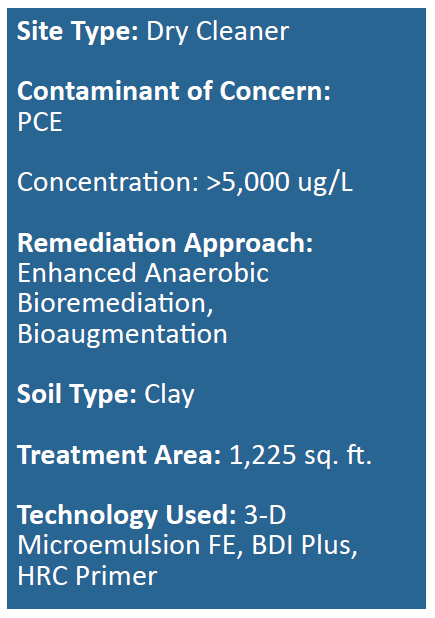
Project Summary
This project was located at an active dry cleaner in northern California. The site had elevated levels of PCE in groundwater due to releases over a period of approximately 60-years. Enhanced anaerobic biodegradation (EAB) was chosen to remediate the site. A pilot study program was implemented using a combination of 3-D Microemulsion®, HRC® Primer and BDI® Plus. Significant contaminant reductions were observed within six months of the first application.
Remediation Approach
An in situ EAB pilot study program was implemented to address elevated levels of PCE concentrations in middle zone groundwater just north of site. 3-D Microemulsion, HRC Primer and BDI Plus were applied through 15 bore holes to depths of 60 feet. Early injection attempts posed challenges due to the formation not accepting the required volume (surfacing). Regenesis provided a modified design reducing the amount of water needed for 3-D Microemulsion and suggested an alternative injection approach in the field which allowed for a more efficient injection within the target treatment zone.
Technology Description
3-D Microemulsion is an engineered electron donor material that offers a novel 3-stage electron donor release profile, pH neutral chemistry and is delivered on-site as a factory emulsified product.
HRC Primer is a less viscous version of the standard Hydrogen Release Compound (HRC) product. It is a thinner, water-like compound that is typically injected into an aquifer where it releases lactic acid at a rate faster than standard HRC (several weeks), but at a slower, more controlled rate than dispersing aqueous simple sugar solutions or straight lactic acid (several days).
Bio-Dechlor INOCULUM® Plus is an enriched natural microbial consortium containing species of Dehalococcoides sp. (DHC). This microbial consortium has since been enriched to increase its ability to rapidly dechlorinate contaminants during in situ bioremediation processes.
Successful Bioremediation at a Former Air Force Base Fire Training Area
Carbon Tetrachloride Concentrations Reduced Below Treatment Goal within 8 Months
Project Highlights
- Air Force Base contaminated with high levels of carbon tetrachloride due to on-site firefighting training.
- 97% reduction in contaminant within three months.
- Carbon tetrachloride reduced to below detection limits.

Project Summary
Training exercises at Texas Air Force Base resulted in an impact to soil and groundwater by trichloroethylene (TCE) and carbon tetrachloride. A monitored natural attenuation study conducted indicated that chlorinated solvents at the plume would naturally decline to acceptable levels after 30 years of monitoring.
After over 14 years of monitoring, contaminant reductions were not proceeding as quickly as predicted and additional remediation was advised. It was determined that limited anaerobic activity was present and biostimulation was a viable option. A pilot test was conducted on-site. The objective of the project was to determine the feasibility of injection into the shallow, discontinuous groundwater unit. The pilot test was also designed to determine if the residual TCE and carbon tetrachloride could be biodegraded through enhanced bioremediation and reduced to below 5 ppb (the Texas Risk Reduction Program limit).
Remediation Approach
3-D Microemulsion® was injected into 30 points at the site; approximately 380 gallons of the product was applied per boring at the site. Initial results indicated a significant reduction in concentrations of parent chemicals – carbon tetrachloride was reduced by 95% within 1 month post-injection and 97% within 3 months of injection within the source area. A monitoring well 50-feet downgradient of the source area experienced a 69% reduction by the third month as 3-D Microemulsion began to reach the well location.
Follow-up injections were applied downgradient of the source area and also in a barrier configuration several hundred feet dowgradient of the source were implemented about 6 months after the pilot test. The combination of the pilot test and full-scale application resulted in a 97.8% reduction in carbon tetrachloride 8 months post-injection with chloroform, methylene chloride, and chloromethane remediation daughter products on a downward trend. High TCE concentrations were effectively treated as well with TCE peaking after injections to 126 ppb and then being reduced within a 3-month period to 0.2 ppb.
Technology Description
3-D Microemulsion is an engineered electron donor material that offers a novel 3-stage electron donor release profile, pH neutral chemistry and is delivered on-site as a factory-emulsified product.
REGENESIS® Achieves MCL Cleanup Goals at New York Manufacturing Facility
cVOC Contamination Successfully Treated Using PersulfOx® and 3-D Microemulsion®
Project Highlights
- 99% reduction of target compounds achieved on-site
- TCE levels reduced from 8,000 ug/L to <5 ug/L to meet site goals
- Integrated remediation approach using PersulfOx® and 3-D Microemulsion® (3DME)
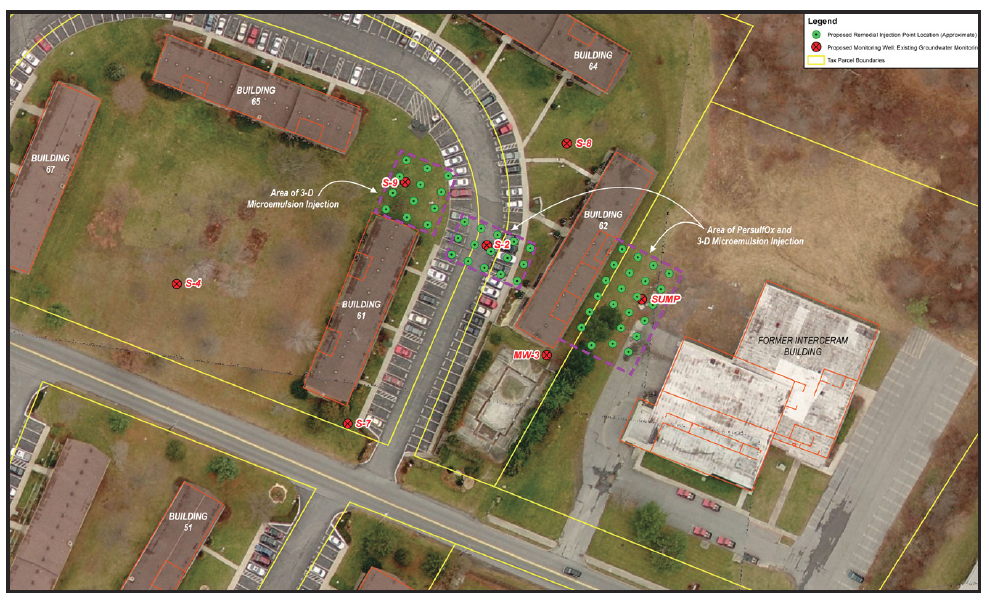
Project Summary
A manufacturing facility in New York was contaminated with high levels of chlorinated solvents. TCE levels were as high as 8,000 ug/L. A combined remedies approach was established to address the migrating plume. The goal of the application design was to reduce cVOCs in the source area, reduce potential for vapor intrusion and address any cVOCs that may migrate into the area downgradient of the manufacturing facility.
An integrated remediation strategy using PersulfOx and 3DME was implemented on-site. Two PersulfOx applications were completed. Results from the In Situ Chemical Oxidation (ISCO) treated area showed >99% reduction of target compounds. A total of 11,600 pounds of PersulfOx was applied on-site. 3DME was applied to enhance anaerobic biodegradation in downgradient locations and within the PersulfOx-treated area. A total of 8,400 pounds of 3DME was applied. While groundwater contamination in the ISCO treated area was reduced to clean-up standards, the goal of the 3DME application was strictly preventative. The client wished to address any potential plume migration from any cVOCs that may be present beneath the building.
Technology Description
PersulfOx is a sodium persulfate-based chemical oxidation technology which destroys both hydrocarbon and chlorinated solvent-type contaminants in the subsurface. PersulfOx contains a built-in catalyst which activates the persulfate component and generates contaminant-destroying free radicals without the need for the addition of a separate activator.
3-D Microemulsion is an engineered electron donor material that offers a novel 3-stage electron donor release profile, pH neutral chemistry and is delivered on-site as a factory-emulsified product.
Results
The use of PersulfOx safely and effectively reduced TCE levels to regulatory standards providing a 99% reduction of cVOC’s achieved on-site. In addition, the integration of 3DME as a precautionary safety measure addressed the potential for plume migration that was thought to be present.

 Americas
Americas Europe
Europe Français
Français Deutsch
Deutsch Italiano
Italiano Español
Español

